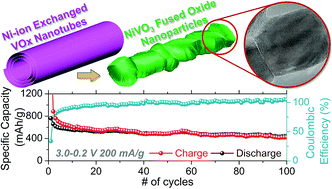NiVO3 fused oxide nanoparticles – an electrochemically stable intercalation anode material for lithium ion batteries†
Abstract
For oxides, especially as lithium-ion battery anodes, it is important to engineer the material not only to improve the kinetics of reversible lithiation efficiency, but to avoid capacity and voltage fading, and side reactions from conversion mode processes that can sometimes occur in tandem with intercalation. We report the first electrochemical evaluation of NiVO3 as an intercalation anode material for Li-ion batteries, which offers a high capacity with negligible fading without conversion mode side reactions. Binary metal oxide NiVO3 fused oxide nanoparticles (Ni–FONPs) are formed via thermal reduction of Ni-doped vanadium oxide nanotubes (Ni-VONTs). The electrochemical performance of Ni–FONPs is contrasted with that of a composite of Fe2O3 and V2O3 (Fe–FONPs) with a similar morphology, synthesized using a similar process from Fe-doped VONTs. Galvanostatic cycling reveals that the binary metal oxide Ni–FONPs exhibit superior electrochemical performance compared to the Fe–FONPs by avoiding segregation into two oxides, one of which ordinarily cycles as a conversion mode material. The new anode material, Ni–FONPs, demonstrates state-of-the-art specific capacity retention (78% from the 2nd to the 500th cycle) and significantly long cycle life (500 cycles) when cycled using a specific current of 200 mA g−1 in a conductive additive and binder-free formulation. Limiting the lower voltage to ∼0.2 V avoids separate oxides of Ni and V, which independently, are detrimental to cycle life and capacity retention. Systematic analysis of differential capacity obtained from galvanostatic voltage profiles over 500 cycles offers a detailed insight into the charge storage mechanism and electrochemical behaviour of this stable NiVO3 anode material.



 Please wait while we load your content...
Please wait while we load your content...